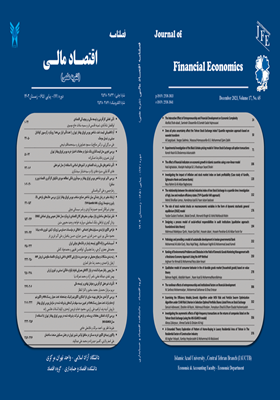A Grounded Theory Exploration of Pattern of Home-Buying in Luxury Residential Area of Tehran in The Residential Sector of Construction Industry
Subject Areas :
Financial Economics
ali asghar velayati
1
,
Kambyz Heydarzadeh
2
,
Mohammad Ali Abdulvand
3
1 - azad universityess Management Department, Science and Research Unit, Islamic Azad University, Tehran, Iran
2 - Department of Business Management, Science and Research Unit, Islamic Azad University, Tehran, Iran.
3 - Department of Business Management, Science and Research Unit, Islamic Azad University, Tehran, Iran
Received: 2023-10-12
Accepted : 2023-12-13
Published : 2023-12-22
Keywords:
O10,
M21,
Keywords: patterns of buying,
luxury housing,
district 1and 3 of Tehran JEL classification: O32,
Abstract :
Abstract
This research has been used to get to know the pattern of housing purchase and through qualitative research with a contextual study approach to achieve the goal of the research. Sampling in the study was done by snowball method and data collection reached saturation by conducting 14 interviews. In order to collect information, buyers looking for a house, consumers living less than 6 months, builders and investors, and architects and designers were interviewed. The results showed that the pattern of purchasing luxury housing from the point of view of investors and builders includes 11 categories (determining the construction site, construction process, investment return, business partners, construction cost, obtaining municipal permit, construction time, economic period of construction and instrument, effective factors in persuasion to buy, characteristics of buyers, buying and selling process in the region); Architects and designers, 4 categories (expectations of the buyer, architect's design style, characteristics of construction in the region, factors influencing purchase); Consumers living less than 6 months, 3 categories (satisfaction with construction, making changes in the house, buyer's expectations); Buyers looking for a house have 4 categories (buyer expectations, buying time, how to choose a house, making changes to the house).
References:
فهرست منابع
باصری، بیژن؛ کیانی، غفار؛ ملکیپور، محمود (1400). جذابیت مسکن به عنوان یک دارایی مالی در برابر پوشش تورم و اثرگذاری آن بر تقاضای مسکن در ایران. فصلنامه اقتصاد مالی، شماره 55، تابستان، صص 79-105
دژپسند، فرهاد و محتوی،لادن (1393). بررسی همگرایی بلند مدت قیمت مسکن در مناطق شهر تهران. فصلنامه علوم اقتصادی، سال 8، شماره 26.
دلخواه، جلیل؛ عمویی، ایمان؛ مقدم، امیروحید (1393). بررسی و شناسایی سبکهای تصمیم گیری خرید مشتریان در فروشگاه های زنجیره ای (مورد مطالعه: مشتریان شعب شهر تهران فروشگاه های زنجیرهای اتکا). تحقیقات بازاریابی نوین، سال چهارم، شماره 2 (پیاپی 13)، تابستان
رزاق پسران، سعید؛ نوابخش، مهرداد؛ اسماعیلی، رضا (1399). تحلیل تطبیقی تمرکز بر ابعاد اجتماعی کیفیّت زندگی در مقایسه با ابعاد اقتصادی و مالی در برنامههای توسعه در ایران. فصلنامه اقتصاد مالی، سال چهاردهم، شماره 2، پائیز، صص 175-195.
شهنازی، کریم و انتظار، الناز (1397). برآورد و تحلیل مقایسه ای شاخص های اقتصادی اجتماعی در مناطق شهری استان های ایران طی سرشماری سال 1390 (رویکرد تحلیل مولفههای اصلی). فصلنامه اقتصاد مالی، سال سیزدهم، شماره 46، بهار، صص 217-239.
عظیمی، فریده و حیدرپور، مریم (1392). تهیه الگوی بهینه مسکن در ارتباط با عناصر اقلیمی در شهر شوش. همایش ملی معماری پایدار و توسعه شهری.
_||_
Berkoz, L., Turk, S. and Kellekci, M. (2009). Environmental quality and user satisfaction in mass housing areas: the case of Istanbul. European Planning Studies, Vol. 17 No. 1, pp. 161.
Bender, A., Din, A., Hoesli, M., and Brocher, S. (2000). Environmental preferences of homeowners. Journal of Property Investment & Finance, Vol. 18 Iss 4 pp. 445 – 455.
Clark, W.A.V. and Onaka, J.L. (1983), Life cycle and housing adjustment as explanations of residential mobility. Urban Studies, Vol. 20, pp. 47-57.
De Nisco, A. and Warnaby, G. (2013). Shopping in downtown: The effect of urban environment on service quality perception and behavioral intentions. International Journal of Retail & Distribution Management, Vol. 41 No. 9, pp. 654-670.
Fiedler, T. and Deegan, C. (2007). Motivations for environmental collaboration within the building and construction industry, Managerial Auditing Journal, Vol. 22 No. 4, 2007 pp. 410-441.
Hansen W. G. (2007) How Accessibility Shapes Land Use. Journal of the American Institute of Planners, 25:2, pp.73-76
Karsten, L. (2007). Housing as a Way of Life: Towards an Understanding of Middle-Class Families’ Preference for an Urban Residential Location, Housing Studies, Vol. 22, No. 1, pp. 83–98.
Kauko, T. (2006), “What makes a location attractive for the housing consumer? Preliminary findings from metropolitan Helsinki and Randstad Holland using the analytical hierarchy process”, Journal of Housing and the Built Environment, Vol. 21 No. 2, p. 159.
Kim, T-k., Horner, MW. and Marans R. W. (2013). Life Cycle and Environmental Factors in Selecting Residential and Job Locations, Housing Studies, 20:3, 457-473.
Kain, J. F., and Quigley, J. M., (1970). Measuring the value of housing quality. Journal of the American Statistical Association, Volume 65, Number 330.
Lo, A., & Jim, C. (2010). Willingness of residents to pay and motives for conservation of urban green spaces in the compact city of Hong Kong. Urban Forestry and Urban Greening, 9(2), 113–120.
Tan, T.H. (2012), Meeting first-time buyers’ housing needs and preferences in greater Kuala Lumpur, Cities, Vol. 29 No. 1, pp. 389-396.
Opoku, R.A. and Abdul-Muhmin, A.G. (2010), Housing preferences and attribute importance among low-income consumers in Saudi Arabia, Habitat International, Vol. 34 No. 2, pp. 219-227.
Wu, F. (2010). Housing environment preference of young consumers in Guangzhou, China using the analytic hierarchy process. Property Management, Vol. 28 No. 3, pp. 174-192


